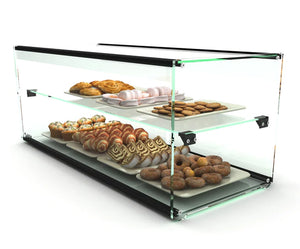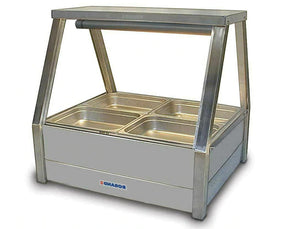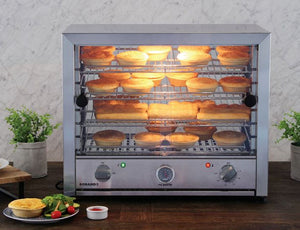There are several types of ice that are commonly used by commercial kitchens, each with its own unique characteristics and advantages. Here are some of the most common types of ice used in commercial settings and their differences:
-
Regular Cube Ice: This is a type of ice that is produced in a cube shape. It is typically made in ice cube trays or specialized ice-making machines, and the resulting ice cubes are typically 2-3 centimetres on each side. Regular cube ice is a popular type of ice for use in drinks because it melts more slowly than smaller ice types, such as crushed ice, which helps to keep the drink cold without diluting it as quickly. It is also commonly used in food service settings to cool food items or to keep items cold during transportation.
-
Half-Dice Ice: This is a type of ice cube that is commonly used in commercial kitchens, bars, and restaurants. It is similar in shape to a full dice cube, but it is half the size. A half-dice cube is typically about ¾ inch in size, which is smaller than a full-dice cube.
The smaller size of the half-dice cube allows it to cool drinks more quickly than a full-dice cube, which makes it ideal for use in high-volume bars and restaurants. It also allows for more efficient use of freezer space, as more cubes can be made in a single tray.
One of the advantages of half-dice cubes is their versatility. They can be used in a wide range of applications, from mixed drinks and cocktails to water and other beverages. They are also easy to dispense and do not clump together like some other types of ice.
-
Full-Dice Ice: A full-dice cube is a type of ice cube that is commonly used in commercial kitchens and bars. It is similar in size and shape to a standard dice cube, but it is slightly larger and has more defined edges. A full dice cube is typically about 1 inch in size, which is slightly larger than a standard dice cube.
The term "full dice" refers to the fact that the ice cube is made from a full tray of ice. In other words, the tray is filled to capacity before the ice is frozen, which results in a larger, more solid ice cube.
One of the advantages of full dice cubes is their size and shape, which makes them ideal for use in high-end cocktails and other drinks that require a large, solid ice cube. The larger size of the full dice cube allows it to cool drinks more slowly, which helps to prevent dilution and maintain the integrity of the drink. The defined edges of the cube also make it visually appealing and add a touch of elegance to the drink.
-
Crescent or Half-Moon Ice: This is a type of ice that is similar in shape to a half-moon or a crescent. It is a relatively new type of ice that was introduced in the 1960s by the Ice-O-Matic company. Crescent ice is made using a unique freezing process that results in a shape that is thinner on one side and thicker on the other. This shape allows the ice to stack neatly in a bin without clumping together, which makes it easier to handle and store.
Crescent ice is a popular choice for commercial kitchens, particularly in the food service industry, as it cools drinks quickly and melts slowly. Its unique shape also helps to minimize splashing when drinks are poured over the ice. Crescent ice is often used in restaurants, cafes, bars, and other food service establishments where drinks are a significant part of the business.
-
Nugget, Pellet or Chewable Ice: Is made by compressing flakes of ice together. It has a unique texture that many people enjoy, and it is often used in slushies, smoothies, and other frozen drinks. Nugget ice is also ideal for use in salad bars and other food displays, as it helps to keep food cold and fresh.
-
Flake, Granular or Cubelet Ice: This is a type of ice that is commonly used in commercial kitchens, food displays, and other applications where it is necessary to keep items cold without damaging them. It is made by spraying a thin layer of water onto a cooled surface, which creates a layer of ice that is then scraped off in flakes.
Flake ice is soft and pliable, which makes it ideal for use in food displays, as it can be easily moulded around delicate items without crushing or damaging them. It is also often used in seafood displays and other food displays to keep food fresh and moist. Additionally, flake ice is frequently used in medical and scientific applications, as it can be easily moulded around items that need to be kept cold or frozen, such as vaccines or biological samples.
One of the advantages of flake ice is that it has a high surface area to volume ratio, which means that it can cool items quickly and efficiently. This makes it an ideal choice for use in commercial kitchens, as it can rapidly cool down hot food or drinks. Flake ice also has a relatively low production cost, which makes it an economical choice for many businesses.
-
Top Hat Ice, Bullet or Gourmet: This is a type of ice cube that is commonly used in commercial kitchens, bars, and restaurants. It is named for its shape, which resembles a top hat or bowler hat. Top hat ice cubes are larger than standard ice cubes, typically measuring around 1.5 inches in diameter and 1.5 inches in height. They have a distinct shape, with a flat top and a curved bottom that tapers inward towards the centre.
This unique shape allows them to be easily stacked and stored in containers, making them a popular choice for use in ice bins and ice storage units. One of the advantages of top hat ice cubes is their large size, which makes them ideal for use in drinks that require a slow melting rate, such as scotch or whiskey on the rocks. They are also commonly used in punch bowls and other large-volume drink dispensers, as they can help to keep drinks cool for extended periods of time.
-
Gourmet (Gala, Octagonal, Cylindrical and Sphere Ice): these are types of high-end ice that are typically used in upscale bars and restaurants. They are often made with high-quality water and are designed to enhance the flavour and presentation of drinks.
Gourmet ice cubes come in a variety of shapes and sizes, including cylinders, octangles, spheres, cubes, and even hand-carved shapes. They are typically larger than standard ice cubes and have a crystal-clear appearance, which makes them visually appealing in drinks.
One of the main advantages of gourmet ice is its slow melting rate, which allows it to keep drinks cold without diluting them too quickly. This is particularly important for high-end cocktails and spirits, as dilution can affect the flavour and quality of the drink.
Another advantage of gourmet ice is its purity. Because it is made with high-quality water, it is free of impurities and minerals that can affect the flavour and appearance of drinks. This allows the true flavours and colours of the drinks to shine through.














Leave a comment